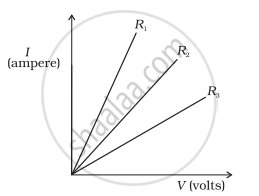Advertisements
Advertisements
प्रश्न
A student carries out an experiment and plots the V-I graph of three samples of nichrome wire with resistances R1, R2 and R3 respectively. Which of the following is true?

विकल्प
R1 = R2 = R3
R1 > R2 > R3
R3 > R2 > R1
R2 > R3 > R1
उत्तर
R3 > R2 > R1
Explanation -
Since the current (I) is plotted on y-axis and potential difference (V) is plotted on x-axis, so the slope of the graph is `1/"R"`. It means higher the slope, the lesser is the resistance. So, R1 will be minimum and R3 will be maximum.
APPEARS IN
संबंधित प्रश्न
An electrical bulb is marked 200V, 100W. Calculate the electrical resistance of its filament. If five such
bulbs are connected in series to a 200V supply, how much current will flow through them?
Find the expression for the resistivity of a material and state the SI unit of resistivity.
What is the necessary condition for a conductor to obey Ohm’s law?
In the circuit shown below in Fig, calculate the value of x if the equivalent resistance between A and B is 4 Ω.

State the limitations of Ohm’s law.
Answer the following question.
Distinguish between Ohmic and non-ohmic substances; explain with the help of example.
Obtain the macroscopic form of Ohm’s law from its microscopic form and discuss its limitation.
The variable resistance is called ____________.
Two conductors are made of the same material and have the same length. Conductor A is a solid wire of diameter 1 mm. Conductor B is a hollow tube of outer diameter 2 mm and inner diameter 1 mm. Find the ratio of resistance RA to RB.
What is the resistance of a conductor through which a current of 0.5 A flows when a potential difference of 2V is applied across its ends?
